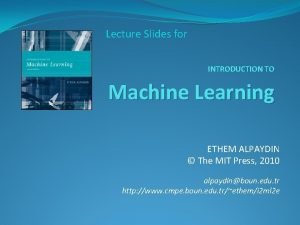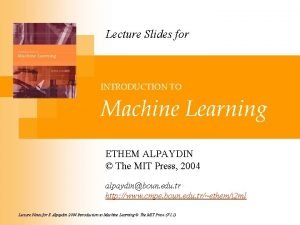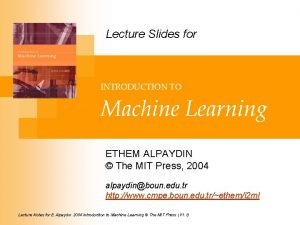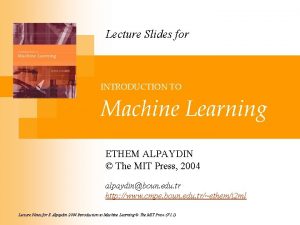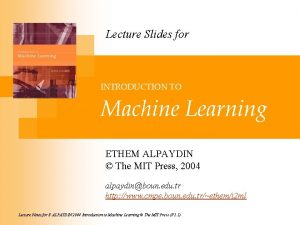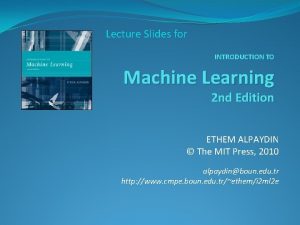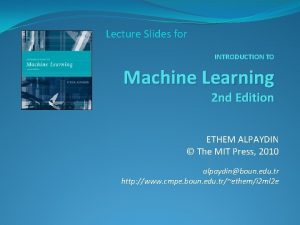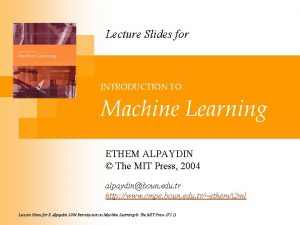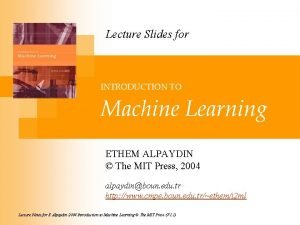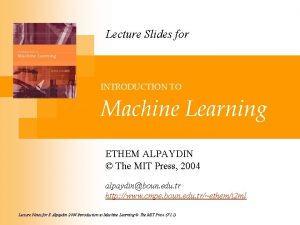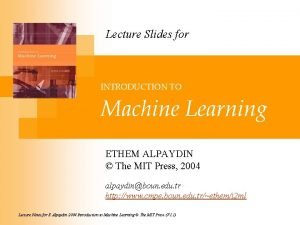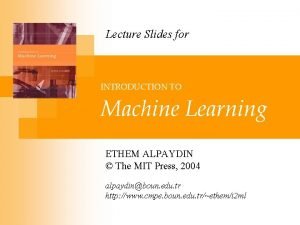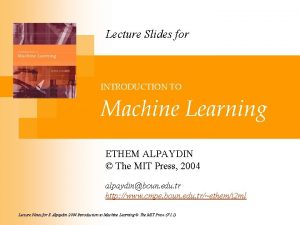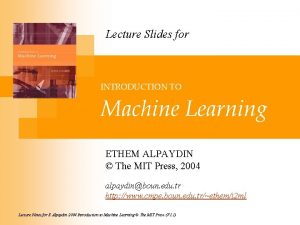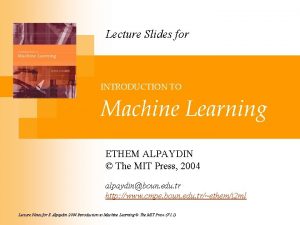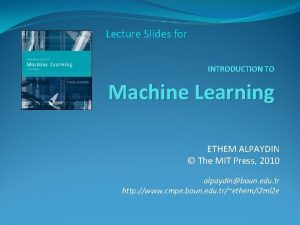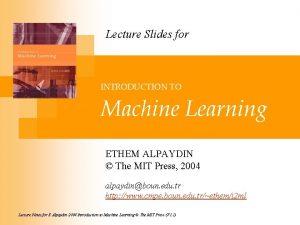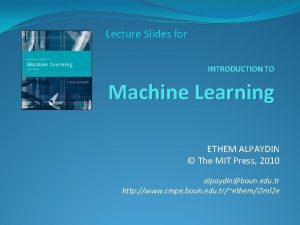Lecture Slides for INTRODUCTION TO Machine Learning ETHEM


















- Slides: 18

Lecture Slides for INTRODUCTION TO Machine Learning ETHEM ALPAYDIN © The MIT Press, 2010 alpaydin@boun. edu. tr http: //www. cmpe. boun. edu. tr/~ethem/i 2 ml 2 e

CHAPTER 2: Supervised Learning

Learning a Class from Examples �Class C of a “family car” �Prediction: Is car x a family car? �Knowledge extraction: What do people expect from a family car? �Output: Positive (+) and negative (–) examples �Input representation: x 1: price, x 2 : engine power Lecture Notes for E Alpaydın 2010 Introduction to Machine Learning 2 e © The MIT Press (V 1. 0) 3

Training set X Lecture Notes for E Alpaydın 2010 Introduction to Machine Learning 2 e © The MIT Press (V 1. 0) 4

Class C Lecture Notes for E Alpaydın 2010 Introduction to Machine Learning 2 e © The MIT Press (V 1. 0) 5

Hypothesis class H Error of h on H Lecture Notes for E Alpaydın 2010 Introduction to Machine Learning 2 e © The MIT Press (V 1. 0) 6

S, G, and the Version Space most specific hypothesis, S most general hypothesis, G h Î H, between S and G is consistent and make up the version space (Mitchell, 1997) Lecture Notes for E Alpaydın 2010 Introduction to Machine Learning 2 e © The MIT Press (V 1. 0) 7

Margin �Choose h with largest margin Lecture Notes for E Alpaydın 2010 Introduction to Machine Learning 2 e © The MIT Press (V 1. 0) 8

VC Dimension �N points can be labeled in 2 N ways as +/– �H shatters N if there exists h Î H consistent for any of these: VC(H ) = N An axis-aligned rectangle shatters 4 points only ! Lecture Notes for E Alpaydın 2010 Introduction to Machine Learning 2 e © The MIT Press (V 1. 0) 9

Probably Approximately Correct (PAC) Learning � How many training examples N should we have, such that with probability at least 1 ‒ δ, h has error at most ε ? (Blumer et al. , 1989) � Each strip is at most ε/4 � Pr that we miss a strip 1‒ ε/4 � Pr that N instances miss a strip (1 ‒ ε/4)N � Pr that N instances miss 4 strips 4(1 ‒ ε/4)N � 4(1 ‒ ε/4)N ≤ δ and (1 ‒ x)≤exp( ‒ x) � 4 exp(‒ εN/4) ≤ δ and N ≥ (4/ε)log(4/δ) Lecture Notes for E Alpaydın 2010 Introduction to Machine Learning 2 e © The MIT Press (V 1. 0) 10

Noise and Model Complexity Use the simpler one because � Simpler to use (lower computational complexity) � Easier to train (lower space complexity) � Easier to explain (more interpretable) � Generalizes better (lower variance - Occam’s razor) Lecture Notes for E Alpaydın 2010 Introduction to Machine Learning 2 e © The MIT Press (V 1. 0) 11

Multiple Classes, Ci i=1, . . . , K Train hypotheses hi(x), i =1, . . . , K: Lecture Notes for E Alpaydın 2010 Introduction to Machine Learning 2 e © The MIT Press (V 1. 0) 12

Regression Lecture Notes for E Alpaydın 2010 Introduction to Machine Learning 2 e © The MIT Press (V 1. 0) 13

Model Selection & Generalization �Learning is an ill-posed problem; data is not sufficient to find a unique solution �The need for inductive bias, assumptions about H �Generalization: How well a model performs on new data �Overfitting: H more complex than C or f �Underfitting: H less complex than C or f Lecture Notes for E Alpaydın 2010 Introduction to Machine Learning 2 e © The MIT Press (V 1. 0) 14

Triple Trade-Off � There is a trade-off between three factors (Dietterich, 2003): 1. Complexity of H, c (H), 2. Training set size, N, 3. Generalization error, E, on new data ¨ As N , E¯ ¨ As c (H) , first E¯ and then E Lecture Notes for E Alpaydın 2010 Introduction to Machine Learning 2 e © The MIT Press (V 1. 0) 15

Cross-Validation �To estimate generalization error, we need data unseen during training. We split the data as �Training set (50%) �Validation set (25%) �Test (publication) set (25%) �Resampling when there is few data Lecture Notes for E Alpaydın 2010 Introduction to Machine Learning 2 e © The MIT Press (V 1. 0) 16

Dimensions of a Supervised Learner 1. Model: 2. Loss function: 3. Optimization procedure: Lecture Notes for E Alpaydın 2010 Introduction to Machine Learning 2 e © The MIT Press (V 1. 0) 17

Question: N-Fold Cross Validation �What happens when N is small? �Extreme =2 �What happens when N is large? �Extreme = N (LOO-CV) �What are you testing (say, Algorithm = decision trees) �Modeling algorithm? �Model for ith fold? �Model for N folds? Lecture Notes for E Alpaydın 2010 Introduction to Machine Learning 2 e © The MIT Press (V 1. 0) 18
 Introduction to machine learning ethem alpaydin
Introduction to machine learning ethem alpaydin Machine learning ethem
Machine learning ethem Introduction to machine learning slides
Introduction to machine learning slides Ethem alpaydin
Ethem alpaydin Introduction to machine learning ethem alpaydin
Introduction to machine learning ethem alpaydin Introduction to machine learning ethem
Introduction to machine learning ethem Introduction to machine learning slides
Introduction to machine learning slides Introduction to machine learning slides
Introduction to machine learning slides Machine learning lecture notes
Machine learning lecture notes A small child slides down the four frictionless slides
A small child slides down the four frictionless slides Change in energy quick check
Change in energy quick check Principles of economics powerpoint lecture slides
Principles of economics powerpoint lecture slides Business communication lecture slides
Business communication lecture slides 01:640:244 lecture notes - lecture 15: plat, idah, farad
01:640:244 lecture notes - lecture 15: plat, idah, farad Concept learning task in machine learning
Concept learning task in machine learning Analytical learning in machine learning
Analytical learning in machine learning Pac learning model in machine learning
Pac learning model in machine learning Pac learning model in machine learning
Pac learning model in machine learning Inductive and analytical learning in machine learning
Inductive and analytical learning in machine learning
